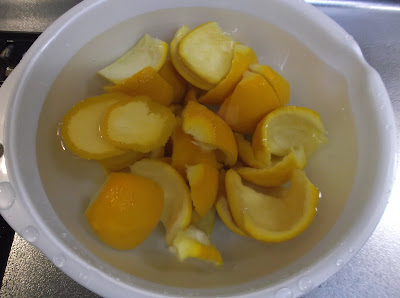Today, I got a box of naga negi, about 20 natsumikan, and about 20 grapefruits from my father.
今日は、父から長ねぎ、夏みかん20個ほど、グレープフルーツを20個ほどもらいました。
I thought I would make marmalade with some of the natsumikan. Coincidentally, Kiki posted about her home-made seville orange marmalade to her blog. I thought I had to make mine soon.
その夏みかんを幾つか使って、マーマレードを作ろうと思いました。偶然にも、Kikiさんが自分のブログに自家製のダイダイ(橙)のマーマレードを載せました。私も早く作らないと、と思いました。
So, I selected these five less stained ones. I measured the weight of each, and they were 290, 280, 310, 350, and 430 g, or 1,660 g in total.
そこで、このあまり汚れていない5個を選びました。それぞれ重さを測ると、290、280、310、350、430 g、全部で1,660 gでした。
I peeled them first.
まず、皮をむきました。
These are the only portions I had to dispose of.
捨てなくてはいけないのは、この部分だけです。
I then blanched the peelings in boiling water for a few minutes and put them in cold water to cool.
次に、皮を熱湯で数分ゆがき、冷水に入れて、冷やしました。
Then, I cut the peelings into small pieces and soaked in cold water. I will let them stand overnight.
次に皮を細かく切り、冷水に漬けました。一晩漬けておきます。
The flesh is in the fridge.
果肉は冷蔵庫の中です。
To be continued.
続く。






2 comments:
I learned Natsumikan are the same as Seville oranges (Citrus × aurantium) - more or less, there may be some minor differences. Quite annoying to cut the peels by hand. I don't use my kitchen processor that often, but it really did a great job with the mandoline blade - I decided on using it after I cut the first orange peels (laugh).
The fragrance of these oranges is heavenly, isn't. The whole house smelled so nice as I was simmering the peels.
Kiki: Natsumikan is Citrus natsudaidai, while seville orange is called daidai 橙 or ダイダイ in Japanese. The former is good to eat (sweet and very sour), while the latter is not suitable for eating, and is used as an ornament on top of kagami mochi in the New Year season.
I will make the marmalade today, and I hope I can smell the fragrance!
Post a Comment